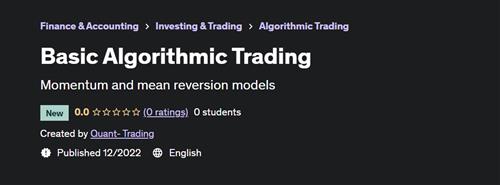
Published 12/2022
Created by Quant- Trading
MP4 | Video: h264, 1280x720 | Audio: AAC, 44.1 KHz, 2 Ch
Genre: eLearning | Language: English | Duration: 19 Lectures ( 1h 25m ) | Size: 583 MB
Momentum and mean reversion models
What you'll learn
Understand the concept of market efficiency and some behavioral biases that explain some market inefficiencies.
Build different algorithms to trade in the markets. You will learn both, momentum and mean reversion strategies and also a factor model.
Separate the data in two sets: In sample data and out of the sample data to build backtesting methodologies.
Learn optimization techniques to find the best parameters for your models.
Requirements
You need previous programming experience using python. You will have acces to all the jupyter notebooks where the models are explained. You also need to be familiar with trading concepts. Previous trading experience is desired.
Description
In the basic algorithmic trading course you will learn how to build momentum, mean reversion and factor models. The course is divided in 6 different topics:1. Introduction: You will understand the concept of market efficiency and also why markets don't always behave that way. One of the main causes is related to behavioral biases. You will learn some of them. You will also learn a simple test to see if a market is efficient or not.2. First Momentum Model - Alexander filter: This is a trend following system that was proposed by a professor at MIT. We will explore different variants of the models. Here you will learn how to run optimizations on python to find the best parameters for the model. 3. Second Momentum Model - Break out model: This is a trend following system inspired in a trading rule that was very profitable in commodities markets. The rule was implemented by a group of traders known as the turtle traders. In this model you will learn how to run a logistic regression to predict the direction of a trend.4. Mean Reversion Model - Pairs Trading: This is a mean reverting strategy using a pair of assets that are fundamentally related. 5. Factor Model: In this model you will learn how to select explanatory variables that can be used to build a successful trading strategy. This kind of models are used in high frequency trading strategies. 6. Final remarks: We will explain how to select optimal trading size based on the Kelly Criteria. We will also revisit backtesting methods.
Who this course is for
Independent traders that want to move from discretionary to rule base trading.
Institutional traders that want to understand different models that help them in their daily trading activities.
Programmers that want to enter the trading/investing sector.
Financial advisors with quantitative background that want to have better recommendation systems.
Quants that want to adquiere new trading tools.
V
https://www.udemy.com/course/basic-algorithmic-trading/
Download From 1DL
https://1dl.net/fnqwcf9mfevt/gxdsg.Basic.Algorithmic.Trading.rar

https://rapidgator.net/file/ab3406d6b94bfad9be65f3da3fbb9d83/gxdsg.Basic.Algorithmic.Trading.rar.html

https://uploadgig.com/file/download/9386A6b1559c76b4/gxdsg.Basic.Algorithmic.Trading.rar

https://nitroflare.com/view/7AEA64F7D2E30AC/gxdsg.Basic.Algorithmic.Trading.rar
Links are Interchangeable - No Password - Single Extraction
